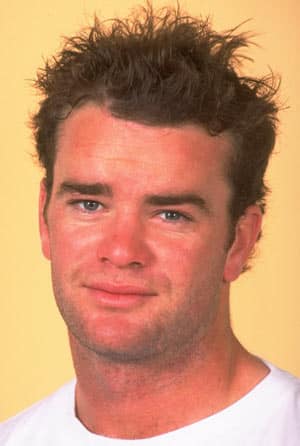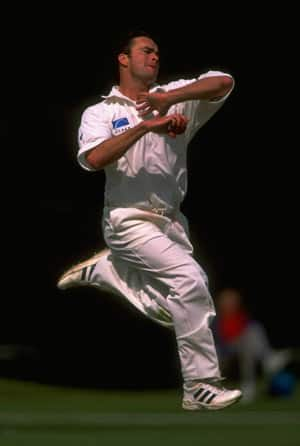
Bharath Ramaraj
(Bharath Ramaraj, an MBA in marketing, eats, drinks and sleeps cricket. He has played at school and college-level, and now channelises his passion for the game by writing about it)
Written by Bharath Ramaraj
Published: Nov 20, 2013, 04:58 PM (IST)
Edited: Nov 20, 2013, 04:58 PM (IST)


Dion Nash © Getty Images
Dion Nash’s career was blighted by serious injuries, but every time he made a comeback into the New Zealand set-up by showcasing dogged determination. Bharath Ramaraj looks back at the career of New Zealnd’s former pacer — Dion Nash.
During the mid 1990s, New Zealand cricket was going through turbulent waters. New Zealand’s premier batsman Martin Crowe was dogged continuously by a knee injury. The national team was struggling to make a mark at the international level too.
Just when it seemed like darkness would envelope New Zealand’s cricket, like a shining light the Auckland born bowling all-rounder Dion Nash offered hope. He could bowl at brisk pace and generate enough movement either ways to trouble the batsmen. He also showcased ability to do well with a willow in hand.
It was way back in 1992 when Indian cricket-enthusiasts first heard of Nash. He had hardly played First-Class games then, but when selectors plumped for him to play against India Under-19s, it proved to be the turning point of his fledgling career. He shone like a beacon on that tour by taking two five wicket hauls and essaying two fine hundreds. He soon made his Test debut against Zimbabwe in 1992.
Nash, known for playing cricket with a touch of bravado and enthusiasm played 32 Tests and 81 One-Day International (ODIs) for New Zealand. It could have been a lot more, but just like many others cricketers form New Zealand during the 1990s, his career was blighted with injuries.
Early days
Dion Nash grew up in Dargaville, a regional service centre north of Auckland. Nash was always interested in taking up sports. He didn’t just play cricket, but was also interested in other sports like basketball and rugby. He even won fulsome praises for being a fine fullback in rugby. Nash though was a sports fanatic; even academically he did reasonably well. John Graham, then headmaster at Auckland Grammar School, where Nash studied during his formative years said that he was “immaculately behaved and above-average academically”. Nash climbed his way up the ladder and studied at Otago University.
Even during his younger days, Nash had a penchant for bowling fast. However the motivation for being at good pace was perhaps something else. Nash believes it was to do with “to get the bat back”. By 1989, Nash earned a sports scholarship to the prestigious Auckland Grammar School.
Just when his career was going in the right direction, his progress was hit by an intercostals muscle tear that ruled him out for most part of 1991 season. But he was able to erase the fine lines of pain and distress and convalesced from the injury. Just in the nick of time, he was selected to tour India to play Under-19 games and he never looked back from there on.
Dion Nash makes his mark in the international arena
Writer’s first impressions of Nash was of watching him in a Test match played between New Zealand and India at Hamilton in 1994. In a match ruined by rain, he took just one wicket. However, it was unmistakable that here was a bowler who unlike many of his predecessors from New Zealand, could hustle the batsmen for pace and had the uncanny ability to get enough movement off the surface to take wickets.
At the beginning of year 1995, Nash and his New Zealand teammates Stephen Fleming and Mathew Hart made headlines for all the wrong reasons. Along with future captain Fleming and left-arm spinner Hart, he was involved in a drug scandal, where he smoked cannabis. He was duly suspended for it.
Many years later, Nash spoke about the incident and said, “I think everyone realises I was a bit stupid at the time. I don’t think it helps having a name that rhymes with hash.”
Curiously by then, Nash had already become one of the upcoming players to watch out for. On his first tour to the Old Blighty in 1994, he had taken the cricketing world by storm by snaring 11 wickets and by showcasing fine prowess of adhesion with the willow at Lord’s. The peace and tranquillity of quintessentially, well-manicured lawns of Lord’s seemed to motivate Nash to raise his game. Interestingly, he wouldn’t have played that game, if New Zealand’s key bowler Danny Morrison wasn’t down with an hamstring injury. England former fast bowler, Fred Trueman not known to shower praises even went onto say, “a star is born.”
Even though, Nash overcame the unfortunate incident of being suspended for taking drugs in 1995, he was increasingly being troubled by a back injury. By mid 1996 when he went to play Middlesex for his second season in County Cricket, he was struggling to turn up and bowl because of excruciating pain in his back. Strangely, scans didn’t show anything serious. He could only complete two games for Middlesex, before returning home. Only in New Zealand was he diagnosed with a stress fractures in his lower spine.
Nash bemoaned lack of guidance from those who are paid to prevent injuries, he said, “It hadn’t been drilled home enough to me, as a professional, that I had to use what little down time I had doing rehab work on my muscles and back, rather than just taking the wear and tear day after day.”
With time, Nash struggled to get himself motivated to make a comeback from what was a career threatening injury to full-time cricket. He even started working as a part-timer in a bar. But it was then that he realised his true love for the game. He told Waikato Times, “I want to get back playing, that’s the most important thing in my life.”
By working hard with the physiotherapist Graham Nuttridge and tinkering with his bowling technique under the guidance of John Bracewell, he came back to playing First-Class cricket for Northern Districts. By 1997-98 season, he was playing for Northern Districts as an all-rounder.
Nash also knew that his bulging disc problem was never going to go away and he just had to monitor it continuously and manage it as much as he could. He made a welcome return to international cricket by playing in two Tests against Zimbabwe in 1998. However, it was in the Test series against India by the end of 1998 season that Nash again caught the eye of cricket pundits. His miserly spell of three for 20 in the second innings and his superlative knock of 89 in the first innings of the first Test at Wellington were instrumental in helping New Zealand to overcome a stiff challenge for India and defeat them. Incidentally, it turned out to be a great Test match not just for Nash, but for another mercurial all-rounder — Chris Carins.

Dion Nash bagged 93 wickets in 32 Tests for New Zealand © Getty Images
When Fleming left the field during the first ODI match against India at Taupo with a groin strain, Nash was elevated to captain the side. He must have felt like flying on the wings of a fabled dream, as it wasn’t long ago that there was a feeling he won’t play again for New Zealand. Despite New Zealand losing the Test series and narrowly going down in the ODI series to a vastly superior South African set-up that season, critics showered praises on for his aggressive captaincy.
Joseph Ramanos in the Listener wrote, “if we are searching for the x-factor, it was Nash.” Romanos further said, “… the ingredient that has really made the difference and has clearly lifted the side a full level, is the permanent presence of Dion Nash, the charismatic all-rounder with the penchant for performing best when the going is toughest.”
In spite of all the frenzy surrounding Nash’s skills as a captain, Fleming returned back to captain the side for the 1999 World Cup, where New Zealand did creditably well before bowing out in the semi-final yet again to Pakistan.
It was in the subsequent Test series against England that Nash and his partner-in-crime, Cairns forged a fine pair of new ball operators to send England hurtling towards a series defeat. It was a historic moment for New Zealand, as it was only the second time that they had won a Test series in England.
By the end of year 1999, he sent shock waves through a formidable Indian batting line-up by taking six wickets in the first innings of the Test match played at Mohali. Yes, the wicket had more moisture in it than expected, but to take six wickets in an innings in India takes some doing.
Sunset of Dion Nash’s career
But in the first ODI played at Rajkot, Nash was laid low by a back injury and he took no further part in the series. Despite doing well against the West Indies in 1999, it had become crystal clear that he was playing through pain. It took him almost a year to recuperate from his stress fracture and make a comeback into the team in Zimbabwe by the end of 2000. He never seemed fully fit during the tour. He did make a valuable contribution though, in the second Test at Harare by ending Pommie Mbangwa’s stiff resistance through a run-out and New Zealand won the Test.
As the back injury continued to haunt him, it took another year for him to play a Test match for New Zealand. It came at the Gabba in 2001. Unfortunately, during the course of the Test, he was down with an abdominal and was ruled out of the reminder of the Test series. He though made 25 valuable runs to help New Zealand escape from the follow-on mark. It turned out to be the last Test match he played for New Zealand.
He turned up to play for Auckland Aces in 2001-02, but in one of the games, he was reported for on-field misbehaviour towards the umpire and unacceptable language towards a player too. After his suspension period ended, he did play a few One-day games in a tri-series in Australia. Ironically, it was a capsule hip injury and not the back injury that ended his career. While trying to avoid a run-out in the first final of the tri-series played at Melbourne, he stumbled and fell to get injured. Initially, it was thought that an abdominal strain was keeping him away from the game. However later on, it was found out that he had picked up a serious hip injury at MCG. He never played again for New Zealand and retired from the game in 2002.
Here was a cricketer who was dogged with injuries all the time. But sheer dogged determination, he made a sterling comeback every-time. One can only salute born fighters like Dion Nash for their ‘never say die attitude.’
(Bharath Ramaraj, an MBA in marketing, eats, drinks and sleeps cricket. He has played at school and college-level, and now channelises his passion for the game by writing about it)
This website uses cookies so that we can provide you with the best user experience possible. Cookie information is stored in your browser and performs functions such as recognising you when you return to our website and helping our team to understand which sections of the website you find most interesting and useful.
Strictly Necessary Cookie should be enabled at all times so that we can save your preferences for cookie settings.
If you disable this cookie, we will not be able to save your preferences. This means that every time you visit this website you will need to enable or disable cookies again.
